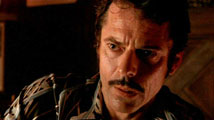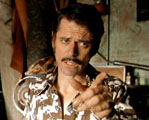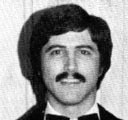|
(1) Despite a small budget, it is not a choppy or
amateurish film. It flows
quite smoothly.
(2) The Hillside Strangler evokes powerful reactions, and bad movies do not cause people to become so emotionally involved. An exploitation film which can provoke such outrage must, ipso facto, be doing what the director intended it to do. This film was designed to shock, to place the viewer inside of the killers' mind-sets, and to make the viewer feel guilty and ashamed for being turned on by watching really hot women get tied up, just as the killers did. It succeeds on all counts. It is a slimy and nasty film, but not one that leaves audiences indifferent. I hated it. I wish I had never seen it. But I can't deny its effectiveness. |
||||||||||||
| Notes on C. Thomas Howell: He did a good job in this film. It may be the best acting of his career. But he does not look healthy. Howell was playing Kenneth Bianchi, who was a strapping guy in his mid 20s when the Hillside Strangler murders occurred. The real Bianchi was bulkier and younger than Howell, yet the actor seemed to have aged and lost weight for the role. He looked skeletal and 50ish. The physical change doesn't seem to have been necessary for the part. On the contrary, why would Howell age himself and lose weight to play a real person who was younger and heavier than he? Makes no sense to me. These pictures illustrate:
The first two pictures of Howell are from the film. The last one is an interview from the special features. The small size of the captures is deceptive, because it hides the signs of age. Click on the third one to get a close-up look at what I mean. The first picture of Bianchi shows him before the time of the stranglings, but the last two show approximately what he looked like at the time of the crimes. Perhaps Howell is ill, or perhaps he changed his appearance for another role he was working on at the same time. I don't know. Howell's inappropriate appearance notwithstanding, he nailed the part. It may not have looked like the real Bianchi, but it certainly seemed to capture the essence of a deeply troubled man. I don't know whether that troubled man was the same kind of troubled man as Kenneth Bianchi, but the portrayal seemed spot-on in the context of the film. |
|||||||||||||
| Tuna's notes
in yellow: This is a biopic of
two serial killers in L.A., Kenneth Bianchi and Angelo Buono, who were
known collectively in the singular as "the Hillside Strangler." It
comes from writer/director Chuck Parello, the designated filmmaker for
serial killers, who also brought us Ed Gein and Henry: Portrait of a
Serial Killer, Part 2. It is Parello's style to remain pretty close to
the real incidents, while lightening the story somewhat with black
humor, and injecting some ideas as to what made the characters become
serial killers. The analysis is minimal. He relies on the enormity of
the events to provide the punch in his films. |
|||||||||||||
|
|||||||||||||






